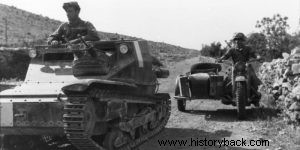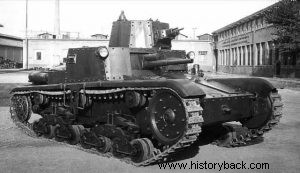
The Italian army did not distinguish itself in the field of armored vehicles during World War II. Shortages of raw materials, inexperience, design inadequacy and the weaknesses of the regime are responsible for this. Nevertheless, the Italian army fielded many thousands of tanks and armored vehicles during the war.
Fiat 3000
The Fiat 3000 was the main battle tank of the Italian army in the interwar period. It was a copy of the French Renault FT. Only 100 entered service in 1921 under the name "Fiat 3000 Modelo 21 Assault Tanks". The tanks were armed with either a 6.5mm machine gun or two 6.5mm machine guns, or a 37mm cannon. The latter received the name Mod. 30. Of the latter, 52 were built. A small number of Mod.21 tanks were exported.
During the war the tanks were designated L5/21 and L5/30 respectively. The tank first saw action in Libya in 1926. It was used against the Ethiopians in 1935-36. A few were used on the Northern Continental Front in auxiliary roles. The latter were used in Sicily in 1943 against the Allies.
The chariot weighed 6 tons. It had a crew of two men. The maximum armor was only 16mm thick. The maximum speed on the road was 21 km/h. and its autonomy of about 100 km.
Fiat L6/40
The L6/40 was a two-man light tank armed with a 20mm cannon and an 8mm machine gun. Some tanks out of a total of 283 produced were equipped with a flamethrower. It weighed 6.8 tons and developed a maximum speed of 42 kph. The maximum thickness of its armor reached 40mm. and their autonomy of 200 km.
From this chariot came the Samovente 47/32 chariot hunter . The tanks were used in the Balkans, North Africa and the Soviet Union with meager results. A small number were used by the Germans and Croats.
L3/33 – L3/35
These tankettes were used extensively by the Italians in Ethiopia, the Spanish Civil War, the Balkans, North Africa, Iraq, China and the USSR. It had a crew of two and weighed 2.7 and 3.2 tons respectively.
The maximum thickness of the armor reached 12 and 14mm respectively, while the former carried a 6.5mm machine gun and the latter two 8mm machine guns. Many were converted to carry the 20mm Solothurn flamethrower or anti-tank. Large number exported. 2-2,500 were built in total. Some were captured by the Greek army and used in 1941.
M11/39
This chariot was the first attempt by the Italians to create a battle chariot. They failed. The tank was poorly constructed, lightly armored and carried its main armament – a 37mm cannon – in the hull rather than the turret. He brought two 8mm machine guns to the tower.
The maximum thickness of the armor was 30mm, the weight 11 tons and the maximum speed only 32 h.a.h. It had a crew of three. Only 100 were produced of which 96 fought and were lost in North and East Africa.
M13/40
These tanks were a most notable effort towards the development and production of a true battle tank. A total of over 2,000 tanks, self-propelled guns and other vehicles of this type were manufactured.
The tank had a crew of four, weighed 14 tons and was armed with a 47mm turret gun and 3-4 8mm machine guns (two on board, one coaxial with the gun and sometimes one in an anti-aircraft role on the turret roof).
The maximum armor reached a thickness of 42mm, the maximum speed 32 h.a.h. and its autonomy of 200 km. However, its bullet-type armor was not durable and its cannon could not penetrate the armor of the main British tanks.
From this came the M14/41 and M15/42 as well as the Samovente 75/18 self-propelled gun and the M40 command tank. Tanks operated in the Balkans and northern Africa. Some were used by the Egyptians against the Israelis in 1948, while in the Italian army few remained in service until the 1950s.
The M14/41 had a diesel engine and a slightly improved top speed, while weighing 14.5 tons. They were built around 800 and were still used after the war. Their boat was used to build the best Italian armored car of WWII, the Samovente 90/53 with its excellent 90mm gun.
The M15/42 carried a 47mm cannon but of 50 caliber, instead of the 32 that the M13/40 and M14/41 carried. It also had increased maximum armor (50mm) and increased maximum speed (38 h.a.h.). It had a crew of four, a weight of 15.5 tons and a gasoline engine.
A total of 118 tanks were manufactured of which 28 were used by the Germans. The tank was the basis for the Samovente 75/34 and Samovente 105/25 self-propelled guns and the Samovente 75/46 tank hunter. An anti-aircraft tank (Semovente 20/70 with quadruple 20mm guns) and a command tank were also created.
M16/43
This tank completely escaped the design standards of the Italian tanks and was a copy, in a way, of the British Cruisers. It carried a 47 mm, 40 caliber gun, had a maximum armor of 30 mm and a maximum speed of 55 h.a.h. Its weight reached 16 tons and it had a crew of four. However only one prototype was built in 1943, too late to have any impact on the race as by then it was already obsolete.
P 26/40
The tank in question was the best that Italy built in WWII. But only 100 were built in 1943-44. It had a crew of four, a weight of 26 tons and a maximum armor thickness of 60mm. It was armed with one 75mm, 34 caliber gun and 1-2 8mm machine guns. The tanks were not used by the Italians but by the Germans after the Italian capitulation.
P43
This chariot would be the heaviest that Italy had on display if it were built. It would have a weight of 29 tons, a crew of five, a maximum speed of 40 kph. and maximum armor thickness of 100mm. It would be armed with either a 90mm cannon (42 or 53 calibers) or a 105mm, but 25 caliber gun. Its design was based on the German Panther, but it remained a design.

Fiat 3000 tank.

L6/40 tank.

Tankette L35.

M11/39 tank.

M13/40 main battle tank in North Africa.

Tank M 14/41.

M 12/42 tank.

M 16/43
tank
Samovente 20/70 anti-aircraft tank.

P 26/40 battle tank.

Wooden model of the P43 tank.
